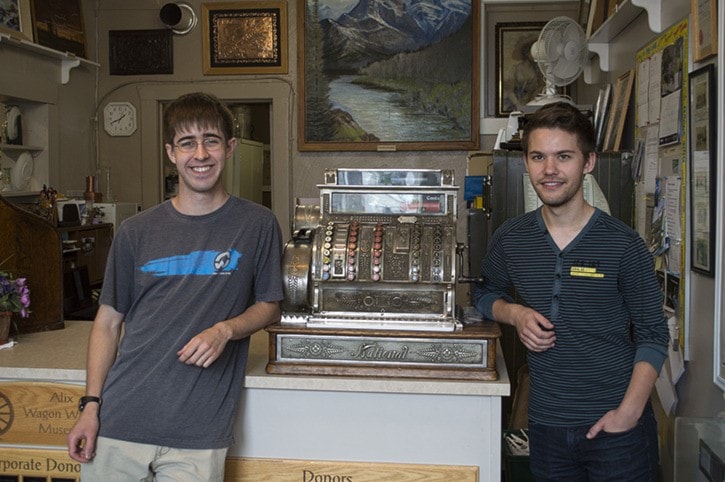As you drive down the quaint and quiet streets of the Village of Alix, there are many things to look at including a rather unique and illustrious building along Main Street that resembles an adobe hut.
The building, with an enchanting mural on the side, is the home of the Alix Wagon Wheel Museum.
Over 40 years ago a group of individuals began collecting artifacts from the region and purchased the building that was the former pool hall. And so the museum was conceived as a testament to Alix’s rich heritage.
For summer interns Adam Parlby and Zach Brooks-Poloway, the museum is an outlet to connect with the community and learn about Alix’s history. Both have been serving at the museum over the past few summers and have found a lot of enjoyment out of showcasing the hands-on history with visitors.
“I just really love history,” said Parlby during a recent tour.
Brooks-Poloway said he enjoys helping the people that walk through the doors who are searching for family history.
“It’s really cool to be able to help them do that,” he said.
The museum is not a tribute to wagon wheels, like some visitors may assume, but named for the shape formed when one places Alix in the hub of a wheel and spokes divide the historic region into numerous school districts.
The heritage mural welcoming visitors into the museum from the street acts as a preview of what visitors will see inside. Created by Ray Bindr, in a fresco-like technique, the mural showcases the history of the off the beaten trail.
As you enter the museum lobby, visitors are likely to notice two things - a giant solid nickel turn of the century cash register and numerous paintings placed on a sky-high shelf that runs around the perimeter of the room.
The paintings, many of scenery and nature scenes done in oil or acrylic, have all completed by local artists over the past century.
“All of the art is done by local artists who lived in Alix at some point,” noted Brooks-Poloway.
Parlby agreed and pointed out a group of paintings by Eddie Wong, who was once the local grocer in Alix. Wong’s paintings are now becoming collectable within art circles.
“He painted so many and he did it for a hobby so when people came in and admired them, he just gave them away,” said Parlby.
Another Alix artist whose paintings are featured on the shelf was the wife of the meat shop opener. Brooks-Poloway said that the wife didn’t like the look of the shop, so she painted large canvases and put them up around the shop so it didn’t look so dark and drab. By chance, these paintings have made their way into the building and are now on display.
Such is the case for the majority of the items in the museum — all of which had a previous home somewhere in the Village and have now made their way into the museum by the way of donations from the community.
The number of visitors entering the museum on any given day is sometimes astounding, even to the ready guides. Brooks-Poloway said just the day before, the museum received two visitors from China, one from Southern California and another from Britain.
“When people from around here come in, they like to see everything that they remember,” said Brooks-Poloway. The museum boasts many items from the pioneer days of Alix and surrounding area.
Exhibits feature Tools of the Trades, Wildlife of Central Alberta, Early Churches, Sports of the Settlers, the Central Alberta Dairy Pool, and the Women of Aspelund.
The museum also has several young visitors throughout the season. From school groups to summer campers, children visit the cultural hub and experience hands-on history through making rope with the cast-iron rope twisting machine or churning butter.
Visitors from other countries are equally intrigued by general Alix history.
“Most of them want to see what it was like to live in a small town back then,” said Brooks-Poloway.
One of the museum’s most significant displays pays tribute to one of Alix’s key figures, Dr. Irene Parlby.
As a noted Alix resident, Irene was elected into the Alberta Legislature in 1921 and was the first female cabinet minister in Alberta. She was also one of the Famous Five, who through a court battle, established that women were “qualified persons,” and entitled to sit in the Canadian Senate.
Adam is a direct descendent of Irene and said she lived in Alix the entire time she was involved in politics. “She actually didn’t really like politics,” he noted of his great-grandmother. “She sort of got pushed into it.”
“It’s not only locally important but it’s culturally significant,” said Brooks-Poloway of the Dr. Irene Parlby exhibit. “She was also the first woman in Canada to be given an honorary law degree.”
Further on in the Early Churches exhibit sits a still-operable organ. Brooks-Poloway and Adam said the organ was found in a grain bin just outside of Alix. A local farmer was cleaning out his bin and lo and behold, there was an antique organ. It was later generously donated to the collection.
The stories are endlessly unique and just as odd as some of the artifacts found in the museum like the giant chunk of butter-flavoured aluminum — the result of a fire at the Central Alberta Dairy Pool of Alix.
The Alix Wagon Wheel Museum is open from 10 a.m. to 5 p.m. daily through until the end of August. In September, the museum is open Tuesday and Saturday from 2 p.m. to 4 p.m.
For more information, contact 403-788-2218.
news@lacombeexpress.com
